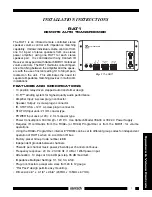
Installation Insta-Trans
Teledyne Analytical Instruments
16
of the cable. A minimum wire gage of 22 is recommended. The maximum
wire gage is limited by the size of the connector. A larger gage wire is
required for longer cable runs due to the voltage drop associated with the
cable resistance. A 1000 foot 22 gage cable will have a voltage drop of
0.59 VDC (29.5 ohms
x
20ma) at full scale. A 1000 foot 18 gage cable
will have a voltage drop of 0.26 VDC (12.96 ohms
x
20ma). The above
voltage will be added to the minimum voltage required for the transmitter.
A typical installation will include a load resistor. The value of the
resistor is dependent on the full-scale output voltage signal required. For a
full-scale output of 5 VDC the resistor value is 250 ohms (5V/20mA.).
For a full-scale output of 1 VDC the resistor value will be 50 ohms
(1V/20mA). The output voltage is also added to the minimum voltage for
the transmitter.
The operating voltage range of the transmitter is 9.3 – 30 VDC. The
wiring and load resistor voltage drops must be included in determining the
minimum voltage requirement. The minimum operating voltage required
with a 500 foot 20 gage cable and a 250 ohm load resistor is 14.4 VDC
(9.3V + (5.1 + 250) ohms
x
20ma).
For Intrinsically Safe (IS) installation, special considerations are
required. The Insta-Trans analyzer has been designed to be Intrinsically
Safe when used with a properly selected and installed safety barrier. This
design utilizes redundant safety features to prevent the Insta-Trans from
becoming an ignition source in the event of a circuit failure. The user
should consult with the proper certifying agency prior to installation. Safety
barriers reduce the possibility of fires or explosion in hazardous locations
by limiting the energy available for ignition. Reference the FM
interconnection diagram D-73226.
3.5 Installing the Micro-fuel Cell
The Micro-fuel Cell is not installed in the cell block when the
instrument is shipped. It must be install before the analyzer is placed in
service.
Once it is expended, or if the cell (trace O
2
) is exposed to air for too
long, the Micro-fuel Cell will need to be replaced (B1 cells are designed
for use in % levels of O
2
such as air). The cell could also require
replacement if the instrument has been idle for too long.
















































